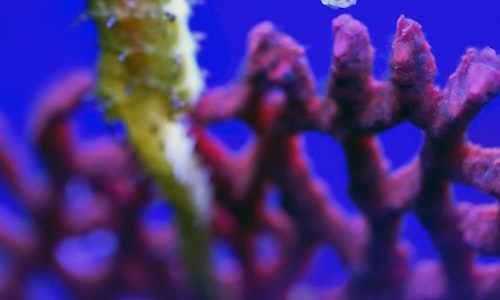Seahorse facts
While investigating facts about Seahorse, I found out little known, but curios details like:
Seahorses engage in an eight hour courtship dance which includes spinning around, swimming side by side and changing colors.
A new species of tiny seahorse has recently been discovered off the coast of Japan. It is abundant but only the size of a grain of rice and well camouflaged, so it’s been hiding in plain sight.
In my opinion, it is useful to put together a list of the most interesting details from trusted sources that I've come across. Here are 50 of the best facts about Seahorse I managed to collect.
-
Seahorses hold a Guinness World Record as the slowest swimmers in the ocean. Dwarf seahorse swims 5 feet per hour.
-
The best known fact about seahorses is that male carries the babies. Mating ritual is complex and it involves dancing when seahorses intertwine their tails and move around tangled. It may last for hours.
-
Some species of seahorses are monogamous (they mate for life), while other stay together only during a breeding season.
-
Seahorses have equine (horse-like) shape of the head, elongated body and curled tail. They do not have scales.
-
Male seahorses have a pouch on the front side of their body. When female deposits her eggs inside the pouch, male fertilizes them internally. Male can carry up to 2000 babies at the time.
-
A seahorses head is shaped to minimize the disturbance of water in front of its mouth before it strikes. This evolutionary "no wake zone” has resulted in a 90% success rate of catching intended prey, one of the highest in the animal kingdom.
-
Seahorses eat plankton and small crustaceans. They do not have teeth and stomach and food passes quickly through their body. Seahorses are able to eat up to 3000 brine shrimp per day.
-
Pregnancy lasts between two and five weeks. Young seahorses look like miniature versions of their parents.
-
Due to new sewage treatment plants in cities along the Black Sea there have been signs of ecological recovery. Species now also include jellyfish, stingrays, goat fish blue sponge, spiny dogfish, seahorses, and hermit crabs.
-
Color of the seahorse body matches with its environment. Some species change their body color under stress conditions or as a part of mating ritual.

What is true about seahorse?
You can easily fact check it by examining the linked well-known sources.
Despite their specific body shape, seahorses have gills, swim bladder and fins, just like all other fish.
Seahorses vary in size from 0.6 to 14 inches in length.
Seahorses interact with each other by producing the clicking sounds. These sounds are also produced during meals.
The Dwarf Seahorse's top speed is 5 feet per hour, making it the slowest-moving fish. It also grows to a length of about 1 inch.
The male seahorse, rather than the female, is the only animal known to man that gives birth and cares for its young.
There are seven species of pygmy seahorses discovered on earth so far. Six of these species can be found in the Philippine Sea. Male seahorses are the ones to become pregnant and they give birth after only 14 days to as many as 12 babies.
Seahorses are so slow they use it as a mode of attack. Copepods sense turbulence and they cannot sense the slow approach of the seahorse until it is too late and they get sucked in.
Threatened and declining shellfish or fish species located in the Bay of Biscay include European eel, gulper shark, long-snouted seahorse, sea lamprey, salmon, spurdog angel shark, and sturgeon.
Seahorse can be easily moved away by the sea current because of its tiny structure and inability to swim fast. Luckily, it has a prehensile tail which allows it to grab a coral branch or sea weed and prevent current-induced movement.
Seahorse monogamy is a common misconception. A 2007 study described Seahorses as "promiscuous, flirty and more than a little bit gay". Rampant flirting was observed (of up to 25 partners a day) and of over 3,000 documented sexual acts, 37% were considered same-sex.
Marine life that can be found in the Gulf of Thailand includes banded sea snakes, longfinned banner fish, batfish, hawksbill turtles, porcupine fish, trigger fish, jellyfish, whale sharks, hermit crabs, giant grouper, white eyed moray eels, seahorses, yellowtail barracudas, sea cucumbers, and blue spotted stingrays, among many other species.